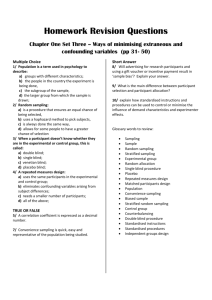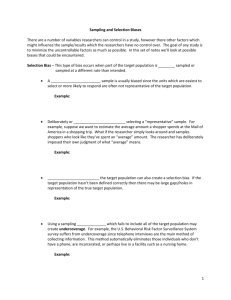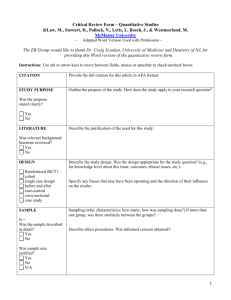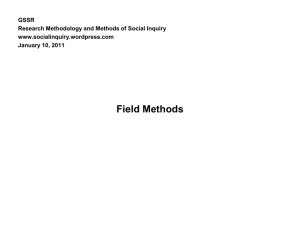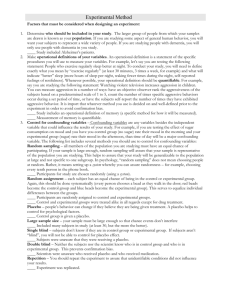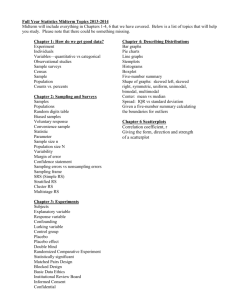File
advertisement
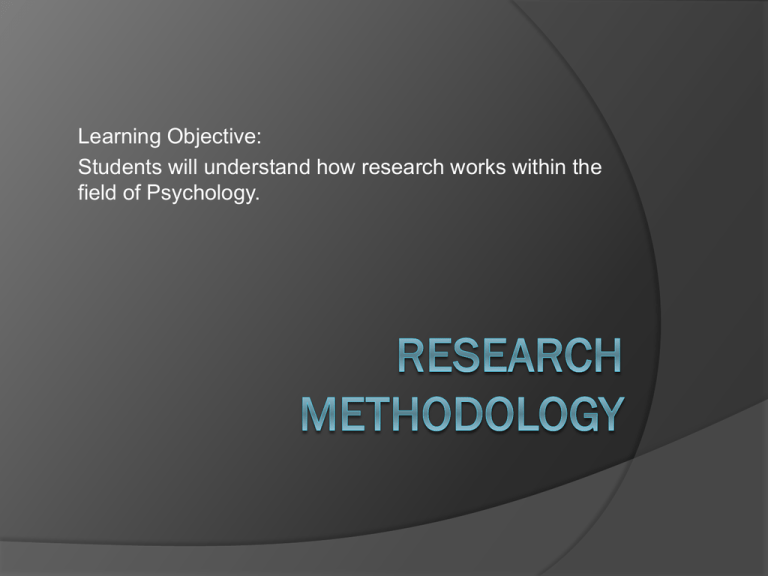
Learning Objective: Students will understand how research works within the field of Psychology. Vocabulary: Copy these words down. Define each word in your own terms with seven words or less and then create a symbol next to the word to help you remember. Research informed consent Deception Quantitative Sampling Variables Reliability Random Statistics Validity Placebo experimental design representative sampling debriefing bias confidentiality replication Ethics integrity Why should we study research? To develop appropriate and practical research skills Evaluate research encountered in other components of the course (and in life!) Read the studies: Environmental Fragrancing Facilitated Communication Ethics in Psychology Get into 5 groups (within the group, number yourselves 1-5– some groups will have multiple 1s or 2s) Read page 1. Answer questions 11-15. Regroup, all 1’s together, etc. Each group will be responsible for a set of principles. As a group, study the principles and become “experts” Return to your home group and report out to the group what you learned. What are ethical considerations? 1. 2. 3. 4. 5. 6. 7. 8. 9. 10. 11. 12. Responsibility to the profession of psychology Acknowledgement of others’ work and publication Honesty in reporting results Competence of the investigator Personal conduct of the investigator Informed consent Respect for participant integrity Justification for using deception Participant’s right of withdrawal Confidentiality of findings Debriefing Use of non-human animals in research What makes Psychology Research “scientific”? Precision Theory = Hypothesis = Define Terms (clarify what you are researching) Skepticism: Motto: Show me!! Reliance on empirical evidence what does the data say Risky predictions: Reliance on the Principal of Falsifiability ○ A theory “could be false” ○ A theory can be tested Openness: Secrecy is a big NO NO! All research, including methodology is available. All research is validated through reproduction. Statement: Misery Loves Company What’s the theory? Develop a hypothesis Define your terms How are you going to design a study? What evidence will you gather? What is the principal of falsifiability? Share your responses? TYPES OF EXPERIMENTS Quantitative Research Methods Experimental Design Your Internal Assessment requires that you replicate a simple experiment and write up your research. In order to do so, you must know these basic research elements: Methods of Psychological Research Method Features Naturalistic Observation observations of human or animal behavior in the environment where it typically occurs Strengths Weaknesses Provide descriptive data about behavior presumably uncontaminated by outside influences May be slow and inconvenient to gather data. Must be covert when gathering data Observer bias and participant selfconsciousness can distort results Methods of Psychological Research Method Features Laboratory Observation observations of human or animal behavior in the controlled environment Strengths Weaknesses Have more control of environment and access to equipment during observations “Lab” environment may make subjects alter behavior Methods of Psychological Research Method Features Strengths Pitfalls Surveys Standard sets of questions asked of a large number of participants Gather large amounts of descriptive data relatively quickly and inexpensively Sampling errors, poorly phrased questions, and response biases can distort results MTV, Cosmo Methods of Psychological Research Cont’d Method Experiments Features Manipulation of an independent variable and measurement of its effects on a dependent variable Strengths Can establish a cause-effect relationship between independent and dependent variables Pitfalls Confounding variables may prevent valid conclusions Methods of Psychological Research Cont’d Method Features Strengths QuasiMeasurement Can provide experiments of dependent strong variables evidence when random suggesting assignment to cause-effect groups is relationships impossible or unethical Pitfalls Lack of random assignment may weaken conclusions Methods of Psychological Research Cont’d Method Features Strengths Pitfalls All of the above Choosing among alternative hypotheses; sometimes generating theories Can expand our understanding of behavior and mental processes Errors, limitations and biases in research evidence can lead to incorrect or incomplete explanations Methods of Psychological Research Method Features Case studies Intensive examination of the behavior and mental processes associated with a specific person or situation Strengths Pitfalls Provide detailed descriptive analyses of new, complex or rare phenomena May not provide representative picture of phenomena (cannot apply to everyone) Variables: Independent, Dependent, Confounding Variables Independent Variables: A variable that an experimenter manipulates- What you are testing Dependent Variables: A variable that measures the change in the independent variable. What changes. Confounding Variables: A variable that causes a “problem” because it is part of the IV or DV or both. Something that changes your results that you weren’t expecting. Population/participants: Participant Groups Experimental Group Group that receives “experimental treatment” Control Group Group that does not receive experimental treatment– used to measure difference in EG. Placebo Group Group receives “fake” treatment to see if results are legitimate in EG. Research Biases and Expectancy Human values: political ideologies, religious doctrines or moral concerns ○ (ie. Human intelligence studies were influence by racial & ethnic biases or women’s health research was shaped by sexist biases) Psychological prejudices: self-deception (want to believe research is true or accurate), “observer effect” (see what they want to see) Psychological biases: anchoring bias (one estimates a new probability based on a familiar one) availability bias (one overestimates a probability that receives a great deal of attention; ie. plane crashes) Hypothesis: “Citrus scent increases productivity” Experimental group: Breathes scented air Independent Variable: Use of citrus scent Use of computer input activities Control group: Breathes plain air Use of computer input activities Dependent Variable: Productivity Number of jobs completed Number of jobs completed Difference statistically significant? Type of Experimental Design Most common: Independent Measures (Between Subject) The results of two or more groups are compared against each other. Participants only participate in one group. Demand Characteristics: A concern is that participants may figure out the “objective” and change their behaviors to anticipate the results of the experiment. Another concern is that there are confounding variables that must be considered when analyzing the data. Authentication Techniques Single Blind: the research participants or subjects do not know the details of the investigation and do not know whether they are being given the experimental drug or the placebo. Double Blind: neither the doctor nor the patient knows whether the given medication is the experimental drug or the placebo. Next most common Experimental Design. Repeated measures (within subject) A group of subjects are tested repeatedly in all testing conditions. Removes confounding variables. However, the subjects may “learn” the sequencing or objective of the experiment and perform better on the test. Counterbalancing: flip-flop participants so that they are in each group, but not in the same order. Other possible designs: Matched Pairs Design: Subjects are matched on a variable that is highly correlated to the dependent variable. Computer skills, athletic ability, etc. Cannot use “quasi-characteristics” Gender, age, or other things that are uncontrollable. Sampling Procedures How are you going to organize your participants? Random Sampling: Random selection of people in experiment. Random assignment of participants to a group. Each participant must have an equal chance of selection. Representative Sampling: Population is divided into subgroups and random samples are taken from each subgroup. ○ Stratified Sampling: The population is divided into mutually exclusive subgroups and random samples are taken from each subgroup. ○ ○ Students at Franklin versus students at Edison Socio-economic status Sophomores vs. Juniors Systematic Sampling: Also known as the Nth name selection. Once a sample population is selected, the the “nth” participant is recorded. Used for very large populations. Of the people who come to the mall, I’m going to record every 19th person I see. Evaluating Research: Reliability: The accuracy of the scores of measure Validity Results measure what is supposed to be measured. Note: Be careful!! A valid measure must be reliable, but a reliable measure is not always valid. Replication: Repeating research to authenticate the research results. Determining if results are reliable. **Your IA will be a replication of a simple experiment. Your goal is to determine if your results authenticate the results of the researcher and determine the research is reliable. Results: Results of experiments or studies are presented with simple statistics. Measure of Central Tendency Mean: average. All numbers are added together and divided by total number of entries. 2+3+7+6= 18/4 = 4.5 Median: the middle entries are put into order, half the results are above the median and half are below the median 1 2 3 4 5 6 7 8 9 10 11 12 13 14 15 16 17 18 19 20 21 22 23 The median is 11.5 Mode: the most frequently occurring result. 111122222334444444444444444555555 ○ The mode is 4 YYYYYYYYYYYYYYYYYYNNNNN ○ The mode is Yes Measure of Dispersion: Determines the variance of data for accuracy and reliability. Range: Determine the difference between the minimum and maximum set of values in the data set. Statistic reporting techniques: Graphs: Bar Graph Line Graph Pie Chart Research Methods: PRACTICE What research method would you use to research the following questions? Using your notes – you and a partner are to discover the research method to answer these questions. Note the independent and dependent variables, if applicable, as well. 1. Why do people stereotype particular ethnic groups? 2. Are men or women more social at work? 3. How do children learn to talk? 4. What causes schizophrenia? 5. Is intelligence related to socioeconomic class? 6. Why do people cooperate with authority figures? 7. Why are some people better at remembering their childhood than others? Dr. Wadsworth’s Rock Music Experiment 1. A factor is being manipulated; an independent & dependent variable; 2. Duration & intensity of workouts (workout performance) 3. Listening to Rock music 4. Work out every day for 2 weeks, 45 minutes each workout. Being monitored as to number of sets & reps they complete and heart rate was monitored. 5. Same as control condition, but add listening to rock music 6. Group A – they received the experimental condition (rock music) 7. Random assignment 8. It reduces preexisting differences between participants 9. Exercise room at fitness center 10. Replication of the experiment 11. Participants in both groups would be balanced or matched based on characteristics related to the experiment such as strength, age or level of fitness 12. Between subject 13. No 14. It would be impossible – can only be used when a placebo is used “Whiff of Things to Come” 1. Studies are being done to explore the use of scents to help people. Everything from worker productivity to relaxation is explored along with the possible explanations. 2. This refers to a European practice in which essential oils are massaged into the skin, absorbed in the bath or diffused through the air 3. Floral: relaxation Spiced apple: reduction of stress Apricot: relaxation Citrus: alertness Vanilla: lowered anxiety Peppermint: alert & productive 4. We do not know “how” it works – are our reactions to particular scents genetically programmed or learned through association 5. Experts here in the U.S. doubt that this system would work here because people resent being manipulated and they may feel that way which can be counterproductive.

